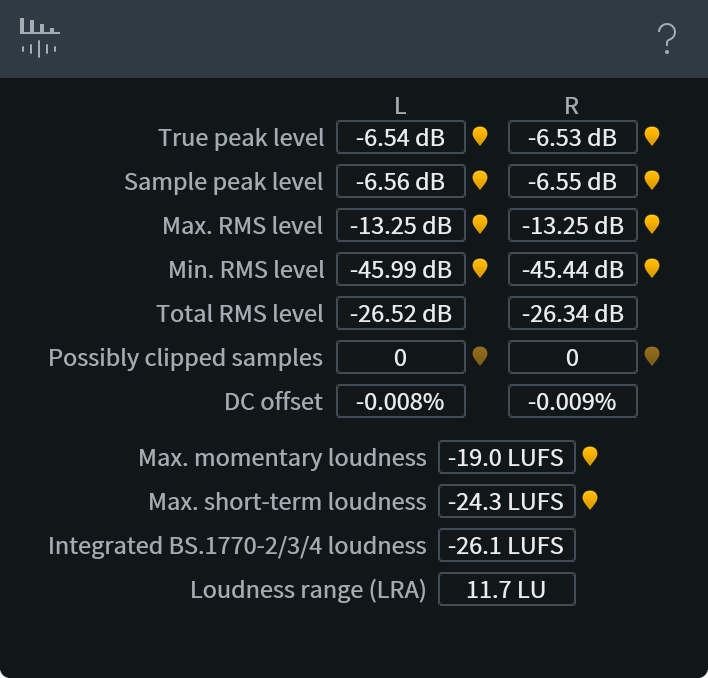Waveform Statistics
Overview
The Waveform Statistics window shows information about the waveform within your current selection. This information can help you find and fix problems like clipping more easily. It is also useful for comparing two similar selections or files.
The Waveform Stats window will update to display information about your active track and can remain open as you switch between track tabs.
Note
- If no selection is made in the active file tab, the Waveform Statistics will populate with values based on the entire file.
- Values that appear in the Waveform Statistics window are based on the full bandwidth of the selection. This means that the Waveform Statistics are gathered based on time selections, and will display values for all frequencies in a time selection, even if the current selection only includes a specific frequency range.
- Selecting the cursor icon next to a value readout will move the playhead to the position in the file where the level was detected.
Controls

- TRUE PEAK LEVEL: The highest peak level detected, including signal levels between digital samples (called ISPs or Intersample Peaks).
- SAMPLE PEAK LEVEL: The maximum level of digital samples in your selection.
- MAX. RMS LEVEL: The highest RMS level detected in the selection.
- MIN. RMS LEVEL: The lowest RMS level detected in the selection.
- TOTAL RMS LEVEL: The RMS level of the entire selection.
- POSSIBLY CLIPPED SAMPLES: The number of samples where the true peak signal level exceeds 0 dBTP.
- DC OFFSET: The amount of DC offset, in percent of the full scale. Hover this value with your cursor to see this level in decibels.
- MAX. MOMENTARY LOUDNESS: Momentary loudness is computed on a K-weighted audio signal using 400-ms windows, as defined by the BS.1770 specification.
- MAX. SHORT-TERM LOUDNESS: Short-term loudness is computed using 3000-ms windows, as defined by the BS.1770 specification.
- INTEGRATED LOUDNESS: Displays the integrated loudness level (as defined by BS.1770-2). Settings in the Loudness module may switch this field to BS.1770-1 standard.
- LOUDNESS RANGE (LRA): Displays the loudness range (as defined by BS.1770). This value reflects the dynamics of audio levels in the selection.
More Information
- TRUE PEAK: True peak reflects the expected peak level of the analog waveform after digital-to-analog conversion. In practice, it is calculated by oversampling of the digital waveform according to BS.1770-3 standard. Different software may measure true peak levels slightly differently, because the standard leaves some freedom in choice of oversampling filters.
- RMS: RX measures RMS using 50-ms windows (more specifically, a Hann window with a 100-ms period) and references levels using either an AES-17 standard (full-scale sine wave = 0 dB RMS) or a “scientific” standard (full-scale square wave = 0 dB RMS). These RMS measurement standards differ by 3 dB and can be chosen in RX Preferences.